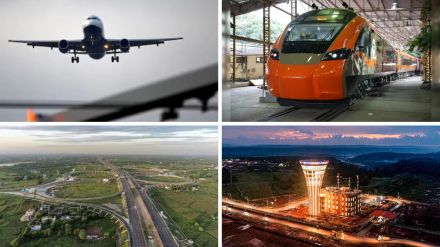India’s aviation sector has experienced a transformative boom under the leadership of Prime Minister Narendra Modi, with the country’s airport infrastructure seeing unprecedented growth in the last decade. Union Minister Jyotiraditya Scindia recently highlighted the remarkable strides made in aviation infrastructure, stating that the number of airports in India has more than doubled under the current government.
‘Infra built in last 10 years more than work done in 60 years of previous govt’
In his remarks, Scindia noted that, while India had only 74 airports in 70 years under previous regimes, the Modi government has increased that number to 157 in just 10 years. Additionally, India’s fleet size has also expanded dramatically from around 400 aircraft in 2014 to 750 today.
“There has been a 180-degree change in the infrastructure after 2014. The Prime Minister dedicated 15 Airports in a single day on March 10. The speed of infrastructure development in the last 10 years has been unmatched, unseen and unprecedented. Sikkim and Arunachal Pradesh did not get any airport in 65 years. Today Sikkim has an airport and there are four airports in Arunachal,” Scindia said.
India’s Infrastructure Revolution: Speed, quality and coverage
The speed of development, he emphasised, has been unmatched in the nation’s history, with infrastructure initiatives ranging from quality and speed to extensive coverage.
A key milestone was on March 10, when the Prime Minister dedicated 15 airports in a single day—a reflection of the accelerated pace of growth in the sector. Scindia further mentioned that states like Sikkim and Arunachal Pradesh, which had no airports for over 65 years, now have operational airstrips, with four airports in Arunachal and a new one in Sikkim.
Budget allocation in infra sectors increased exponentially
The emphasis on infrastructure, Scindia said, is part of a broader strategy to drive economic growth. He highlighted that every rupee spent on infrastructure contributes significantly to GDP growth, providing a multiplier effect on national development.
“Infrastructure plays a very important role in transforming a nation from a developing to a developed nation. Every penny spent on infrastructure leads to a 2.5 to 3 times contribution in GDP,” Scindia said.
He also pointed out that budget allocations for sectors like roads, railways, and aviation have increased exponentially, with capital expenditure seeing consistent growth of 10-15% annually.
Further reflecting the impact of the government’s infrastructure policies, Scindia spoke about the development of India’s road and railway networks. The national highway network has expanded from 91,000 kilometers to 150,000 kilometers in the past decade, and the pace of road construction has more than tripled, from 12 kilometers per day in 2014 to a target of 60 kilometers per day.
These developments have led to tangible economic benefits, including a 20% reduction in freight truck transit times and a significant decrease in logistics costs, aimed at reaching just 9% of GDP.
